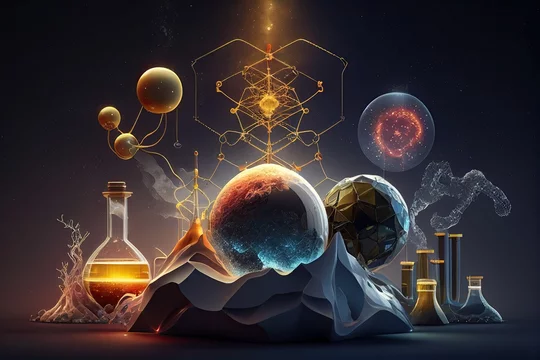The laws of physics are fundamental principles and rules that govern the behavior of the natural world and physical phenomena. They provide a framework for understanding and predicting the behavior of the universe based on empirical observations and mathematical models. These laws describe the relationships between various quantities, such as forces, motion, energy, and matter.
Newton’s Laws of Motion
One of the most well-known sets of laws in physics is Newton’s Laws of Motion. These laws describe the relationship between the motion of an object and the forces acting upon it. Newton’s first law, also known as the law of inertia, states that an object at rest will stay at rest, and an object in motion will continue in motion with a constant velocity, unless acted upon by an external force. Newton’s second law states that the force acting on an object is equal to the mass of the object multiplied by its acceleration. Finally, Newton’s third law states that for every action, there is an equal and opposite reaction.
Law of Gravitation
The law of gravitation, formulated by Isaac Newton, describes the force of attraction between objects with mass. It states that the force of gravity is directly proportional to the product of their masses and inversely proportional to the square of the distance between them. This law explains why objects fall to the ground and why planets orbit around the sun.
Laws of Thermodynamics
The laws of thermodynamics govern the transfer and conversion of energy in systems. The first law, also known as the law of conservation of energy, states that energy cannot be created or destroyed, only transferred or converted from one form to another. The second law of thermodynamics introduces the concept of entropy, which is a measure of the disorder or randomness of a system. It states that in any natural process, the total entropy of a closed system always increases. The third law of thermodynamics describes the behavior of matter at absolute zero temperature, where the entropy of a perfectly ordered crystal approaches zero.
Maxwell’s Equations
Maxwell’s equations describe the behavior of electric and magnetic fields and form the foundation of classical electrodynamics. These equations summarize the relationship between electric charges, electric fields, magnetic fields, and electromagnetic waves. They have been instrumental in the development of technologies such as electricity, magnetism, and telecommunications.
Quantum Mechanics
Quantum mechanics is a branch of physics that governs the behavior of particles at the microscopic level. It describes phenomena such as wave-particle duality, where particles can exhibit both wave-like and particle-like behavior, superposition, where particles can exist in multiple states simultaneously, and quantum entanglement, where particles become correlated in such a way that the state of one particle is dependent on the state of another, regardless of the distance between them.
These examples represent just a fraction of the laws of physics that cover different aspects of the physical world. The laws of physics provide a solid foundation for understanding the natural world and have led to countless technological advancements. They continue to be a subject of study and exploration, pushing the boundaries of our understanding of the universe.
قوانين الفيزياء تشير إلى المبادئ الأساسية والقواعد التي تحكم سلوك العالم الطبيعي والظواهر الفيزيائية. تصف هذه القوانين العلاقات بين الكميات المختلفة مثل القوى والحركة والطاقة والمادة. وتشمل بعض القوانين المهمة في الفيزياء:
- قوانين نيوتن للحركة: تصف هذه القوانين العلاقة بين حركة الجسم والقوى المؤثرة عليه. تشمل قانون نيوتن الأول (العزم الزاوي) والثاني (القوة تساوي كتلة ضرب التسارع) والثالث (العمل ورد الفعل).
- قانون الجاذبية: يصف هذا القانون، الذي صيغه إسحاق نيوتن، قوة الجذب بين الأجسام ذات الكتلة. يقول إن قوة الجاذبية تتناسب مباشرة مع حاصل ضرب كتلتي الأجسام وتتناسب عكسيًا مع مربع المسافة بينهما.
- قوانين الديناميكا الحرارية: تحكم هذه القوانين نقل وتحويل الطاقة في الأنظمة. تشمل القانون الأول (مبدأ الحفاظة للطاقة)، والقانون الثاني (الانتروبيا واتجاه العمليات)، والقانون الثالث (سلوك المادة عند درجة الحرارة المطلقة الصفرية).
- معادلات ماكسويل: تصف هذه المعادلات سلوك الحقول الكهربائية والمغناطيسية وتشكل أساس الكهرومغناطيسية الكلاسيكية. تلخص العلاقة بين الشحنات الكهربائية والحقول الكهربائية والحقول المغناطيسية والموجات elecromagnetic.
- الميكانيكا الكمية: تحكم قوانين الميكانيكا الكمية سلوك الجسيمات على المستوى الدقيق. تصف الظواهر مثل التضاعف الأمواج-الجسيمات والتراكب والتشابك الكمي.

هناك العديد من القوانين الأخرى المهمة في الفيزياء. هنا بعض الأمثلة عنها:
- قانون أوم: يصف العلاقة بين التيار الكهربائي والفرق في الجهد والمقاومة. يقول إن التيار الكهربائي يتناسب مباشرة مع الجهد ويتناسب عكسيًا مع المقاومة.
- قانون فاراداي للتحليل الكهروكيميائي: يصف هذا القانون العلاقة بين التيار الكهربائي المار في الخلايا الكهروكيميائية وتفاعلات التحول الكيميائي التي تحدث فيها.
- قانون البقاء للطاقة: يشير إلى أن الطاقة لا يمكن أن تخلق أو تُدمَر، وإنما يمكن تحويلها من نوع إلى آخر. يُعتبر قانونًا أساسيًا في الفيزياء ويتمثل في مبدأ الحفظ الكلي للطاقة.
- قانون الحفاظ للكمية الحركية: يصف هذا القانون العلاقة بين كمية الحركة لنظام من الجسيمات قبل وبعد التصادم. يشير إلى أن مجموع كميات الحركة قبل التصادم تساوي مجموع كميات الحركة بعد التصادم.
- قانون الحفاظ للزخم الزاوي: يصف هذا القانون العلاقة بين الزخم الزاوي لنظام من الأجسام قبل وبعد التصادم. يشير إلى أن مجموع الزخم الزاوي قبل التصادم يساوي مجموع الزخم الزاوي بعد التصادم.
- قانون انعكاس الضوء: يصف هذا القانون انعكاس الضوء عند اصطدامه بسطح مرآة. يشير إلى أن زاوية الانعكاس تكون متساوية لزاوية السقوط.
- قانون انكسار الضوء: يصف هذا القانون انكسار الضوء عند انتقاله من وسط إلى آخر. يشير إلى أن زاوية الانكسار تتغير بنسبة معينة بين الوسطين.

الفيزياء النووية تهتم بدراسة النواة الذرية والتفاعلات النووية. وهناك عدة قوانين أساسية في الفيزياء النووية، من بينها:
- قانون الحفاظ للعدد الكتلي: يشير إلى أن عدد النيوترونات والبروتونات داخل النواة يبقى ثابتًا في ظروف عادية. أي تغير في عدد النوترونات أو البروتونات يؤدي إلى تحويل النواة إلى نواة مختلفة.
- قانون الحفاظ للعدد النووي: يشير إلى أن عدد النيوترونات والبروتونات مجتمعة (عدد النوكليونات) يبقى ثابتًا في التفاعلات النووية. في تفاعل نووي، يجب أن تكون مجموعة النوكليونات في النواتين المتفاعلتين متساوية.
- قانون انحلال النواة: يصف هذا القانون تحلل النوى الذرية الثقيلة إلى نوى أخف وأكثر استقرارًا. ويشمل ذلك عمليات مثل الانحلال الإشعاعي الألفا والانحلال البيتا والانحلال الجاما.
- قانون الحفاظ للطاقة: يشير إلى أن الطاقة تحتفظ بقيمتها الإجمالية في التفاعلات النووية. يمكن أن تتحول الطاقة من شكل إلى آخر، مثل التحول من الطاقة النووية إلى الطاقة الحرارية أو الطاقة الكهربائية.
- قانون الحفاظ للزخم الزاوي: يشير إلى أن الزخم الزاوي للنواة يحافظ على قيمته في التفاعلات النووية. يمكن أن يتغير توزيع الزخم الزاوي بين النواتين المتفاعلتين، ولكن الزخم الزاوي الإجمالي يظل ثابتًا.

